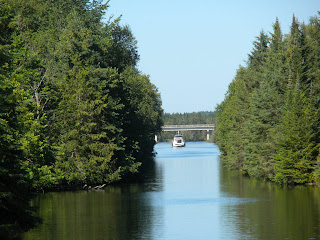July 20: We left Orillia on another calm but hot day. After locking through Lock 42 at a mere 20 ft drop, our first challenge was to traverse the McDonald Cut which is another narrow, rock lined passage. Luckily, no other large boats were coming in the opposite direction.
McDonald Cut-narrow but quite scenic.
A very narrow bridge at the end of McDonald Cut.
Our destination today is Lock 43 at Swift Rapids. You can tell why it got its name: there is a 47 ft drop. We moored at the top of this lock for the night. It is a very rural and quiet location.
July 21: We met an adventurous Canadian couple at Lock 43 who are traveling the Trent-Severn Waterway in a large, motorized canoe. Here they are at the top of the Lock behind us getting ready to Lock down.
Onto our next exciting adventure: Big Chute. This is a marine railway. Boats are lifted via a marine chute and transported over land to a body of water below to continue on the Trent-Severn.
The marine lift at the bottom of Big Chute.
Big Chute in mid air.
The Duddon Pilot entering the flooded marine chute. Photos courtesy of Allan & Terry.
The Duddon Pilot suspended on the marine chute by slings.
The Duddon Pilot being lifted up 58ft. Hold onto your hats!
The view from our boat as we are lifted over the road. Not bad for a boat that generally needs water!
The view from our bow as we begin our descent.
The view looking back up the chute. We are almost at the bottom!
After all the excitement of the Big Chute, we headed for our last Lock on the Trent-Severn Waterway. We moored at the top of Lock 45 for the night and headed straight for a swim..today was so hot it broke records! 37 degrees Celsius which roughly translated is about 98F.
July 22: After surviving the heat wave, we locked down our last lock on the Trent-Severn Waterway and headed for Georgian Bay. Our first stop will be Midland. Georgian Bay is also called the 30,000 Islands which is a misnomer as there are probably over 100,000.
The most unique feature of Georgian Bay is the topography. Land above and below the surface is granite-rocks everywhere. While this makes for interesting viewing, it is challenging for boaters as the depths vary considerably. The water can be 100 ft one minute and then drop off very sharply.
To date, we have been traveling basically on a marine highway. One has to follow the channel and the direction is predetermined. Now we will really have to pay attention to our charts, GPS and keep a visual surveillance. Fortunately, the channels are well marked for most of the routes. It gets interesting when one ventures off into uncharted areas.
We were very fortunate to meet fellow Monk owners, Elena and Owen Smith who keep their boat, Suncee, in Midland. They took us food and beverage shopping. They have been cruising Georgian Bay for over 20 years and very graciously offered to guide us through part of the way and show us a few of their favorite anchorages.
 Typical topography in Georgian Bay. It really is gorgeous. Crystal Clear water..helpful to spot those underwater rocks! |
An Indian marker that was used to point the way for the early inhabitants of this land.
The Duddon Pilot rafted with Suncee, Owen and Elena's Monk in an anchorage off the beaten path.
Our dinghy taking his majesty ashore!
Elena's catch of the day and our supper!
After spending three wonderful days with Elena and Owen, we took our leave and headed off on our own to Parry Sound. We will provision there and then take off on our own to explore Georgian Bay.

























































